
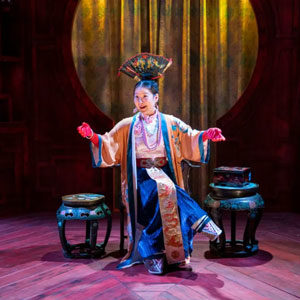 [rating=4]Mia Kang excels in the role of Afong Moy in Lloyd Suh’s acclaimed play “The Chinese Lady.” Based on a true account, the story has to do with a woman from China who was once part of a traveling exhibit which toured major cities in the United States. Originally “hired” by the Carne brothers in 1834 at the age of 14, Afong Moy would sit in a small room in a museum among Chinese artifacts (like vases, tea chests, and Chinese lanterns) and tell stories about her heritage, accompanied by her interpreter and faithful servant Atung (Glenn Obrero). She initially engages the audience by calling Atung “irrelevant”, because he is of a much lower social status than she is. With aspirations to travel throughout the entire U.S.A. and meet all sorts of people, Afong Moy earnestly considers all the good she can do by opening up Americans to understanding Chinese culture and customs. In this show, we watch her daily activities educating audiences while we listen to her impressions of American life.
[rating=4]Mia Kang excels in the role of Afong Moy in Lloyd Suh’s acclaimed play “The Chinese Lady.” Based on a true account, the story has to do with a woman from China who was once part of a traveling exhibit which toured major cities in the United States. Originally “hired” by the Carne brothers in 1834 at the age of 14, Afong Moy would sit in a small room in a museum among Chinese artifacts (like vases, tea chests, and Chinese lanterns) and tell stories about her heritage, accompanied by her interpreter and faithful servant Atung (Glenn Obrero). She initially engages the audience by calling Atung “irrelevant”, because he is of a much lower social status than she is. With aspirations to travel throughout the entire U.S.A. and meet all sorts of people, Afong Moy earnestly considers all the good she can do by opening up Americans to understanding Chinese culture and customs. In this show, we watch her daily activities educating audiences while we listen to her impressions of American life.
As her spoken English gets better and as memories of her parents and her home fade into the background, Afong Moy comes to realize that America has become her adopted country. Despite recognizing the injustices that had been done to Native Americans by European Americans, she internalizes the American ideal of “liberty and justice for all.” Yet her optimism about her position wanes over time. When in the late 1860s, she is replaced in her role by a 14-year-old Chinese woman, first she becomes excited about the prospect of traveling on her own, independent of the exhibit. She wants to connect with people from her own culture in San Francisco, considering that so many Chinese nationals have come to California to seek their fortune during the Gold Rush and then to build the Transcontinental Railroad. But her traveling never happens, and she realizes that she has been looked upon as a piece of property, above and beyond being a mere curiosity. No longer young enough to remain a source of Barnum’s revenue, she has few choices in life. While Atung is also a token Chinese, he has a few more options being a man—and he decides not to accompany Afong Moy but instead remain as the interpreter for her replacement.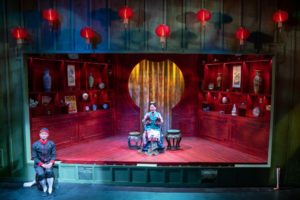
This is the point in the play when Afong Moy’s personal history becomes more and more intertwined with the history of Chinese migration to the United States, and the play morphs into informing us about the lives of Chinese Americans as a group. The focus turns to the growing anti-Chinese sentiment in America in the 1880s. We learn of the hateful violence when the lives of Chinese Americans were being threatened by those in the dominant white population who feared economic competition with them for jobs and income. For example, the Chinese Exclusion Act, which was enacted in 1882, prohibited all immigration of Chinese laborers. Initially intended to last for ten years, the act was renewed in 1892 and was made permanent in 1902.
Not only does the Chinese lady change her perspective on her role and her opportunities (or lack thereof) throughout her lifetime, but her audience changes as well. It is this constant flipping of the audience’s mindset throughout the show that makes this story and this performance especially great. At one moment, today’s theatregoers are meant to represent a 19th century audience, who has paid 25 cents or 75 cents for the privilege of viewing her and the exhibit. At other moments, however, we are meant to be the audience of today. For this play to work properly, what theatregoers must do is to place our collective mindset into the heads of earlier generations of white people, with their conscious or subconscious biases about East Asian women. We must simultaneously see the Chinese lady using a 19th century mindset, such that we believe she is not fully human—as in being a doll or some fragile exotic creature—while, with our modern thinking cap on, we must realize that she is just as human as everybody else. Then, when we are finally instructed to “see me”, the audience must transform itself from one mindset to another, either in our imagination or in reality. This exercise can be potentially eye-opening in confronting racial stereotypes and bigotry and may allow those in the audience to recognize that some form of prejudice may exist even in the modern era, including the harboring of stereotypes and the negative uses of language.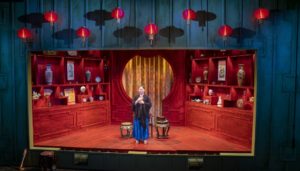
Arnel Sancianco has done a lovely job with the one main set, and properties designer Rowan Due has furnished it beautifully. The costumes are fantastic and reminiscent of both the 19th century and the modern period, thanks to the creativity of costume designer Izumi Inaba. Especially memorable are the boxy, highly decorative shoes worn by Kang (considering the traditional foot binding among high-class Chinese women of that era). Most notable is the work of dramaturg Yiwen Yu, who has provided the audience with an extensive discussion of the original history in the playbill. Plus due to the hard efforts of dramaturgical display designer Dina Spoerl, there is a large map of the United States on the theatre wall that documents in significant detail the major cities where Afong Moy and Atung had once traveled, together with some description of their adventures and relevant dates. The research that went into the making of this show is nothing short of amazing!
Yet there are a few criticisms I have with the production. When Afong Moy and Atung shift radically from showing their public personas to articulating their most private thoughts, we in the audience feel as if we are somehow intruding on them. Perhaps dimming the lights or throwing in spotlights might help differentiate the various aspects of each character’s personality, depending on who they are addressing and when. Some of this is being done already but not often enough. I would also abandon the entire segment where Atung talks directly to the audience about his sexuality and sexual fantasies. It adds nothing to the performance and distracts from the focus on the Chinese lady. If anything, it’s much too vicious. Lastly, a third cast member should have played President Andrew Jackson when Atung serves as the interpreter. That would have better pointed up how he would lie to Afong Moy when translating from English into Chinese.
That said, the ending is spectacular. Afong Moy is heartbroken as the years progress when she sees how poorly Chinese immigrants are being treated by white Americans. “If I had only done my job better,” she keeps repeating, almost as a mantra. Her feeling is that if people were better educated, maybe there wouldn’t be any anti-Asian hatred. Today she would have been 202 years old, and her message is pretty much the same. As a consequence of Kang’s marvelous acting and engaging manner, we see her become the modern Chinese lady as well as the traditional one. In the person of this lady, we can see ourselves. Playwright Lloyd Suh and director Helen Young have chosen to focus on making the audience see Asian Americans as part and parcel of the larger society, with the implicit belief that this might counteract ideologies promoting white supremacy and racial dominance.
The play “The Chinese Lady” points up the fine line between educating people about an ethnic group and its culture in order to widen people’s horizons versus using this same information in a vengeful way: as a weapon to point up the inferiority of a given racial and ethnic minority group. This is a very complicated and sensitive issue having to do with the preservation of one’s unique cultural heritage while being a part of a larger society and culture. In addition, the performance raises all sorts of interesting questions, such as how can one fight against dog whistle politics and hostility against those of East Asian descent? How does one put an end to the hate, divisiveness, and violence against minority groups which have marred present-day America? And what mechanisms can be put into place such that fifty or a hundred years later, a specific ethnic group won’t suddenly lose whatever rights they have or may have previously fought for? One of the highlights of Afong Moy’s work in the museum exhibit is taking an occasional walk where she circles her ornate chair. Her ambling is meant to be analogous to the current situation, where oppression and discrimination by the dominant white population may vanish from one generation to the next, but it rears its ugly head cyclically and all too often.
This is a terrific performance and one that you should not miss!
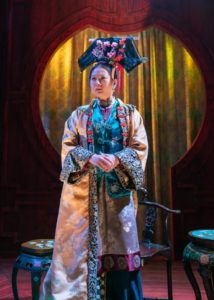 TimeLine Theatre’s production of “The Chinese Lady” is running through June 18, 2022, at Theater Wit, 1229 W. Belmont Avenue, in Chicago’s lakeview neighborhood.
TimeLine Theatre’s production of “The Chinese Lady” is running through June 18, 2022, at Theater Wit, 1229 W. Belmont Avenue, in Chicago’s lakeview neighborhood.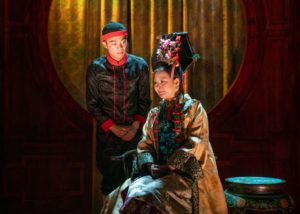
Tickets are $42 (Wednesday through Friday), $49 (Saturday evenings), and $57 (Saturday and Sunday matinees).
Student discount is 35% off regular price with valid ID.
$25 tickets are available to U.S. military personnel, veterans, first responders, and their spouses and family.
Discounted rates for groups of 10 or more are available.
Performance schedule:
For a full calendar of performances including a listing of pre- and post-show discussions and virtual discussions, please turn to: https://timelinetheatre.com/calendar/.
Note that performances on Thursday, May 19 and Tuesday, June 14 will have a capacity cap and seating chart so that patrons can sit with additional space allocated between parties.
Open-captioned performances will take place on Friday, June 10 and Saturday, June 11.
An audio-described performance will take place on Friday, June 17.
For more information or to purchase tickets, visit: https://timelinetheatre.com/events/chinese-lady/ or call the TimeLine Box Office at 773-281-8463 x6.
Theater Wit is accessible to wheelchair users and visitors who need to avoid stairs.
COVID precautions are still in effect. Vaccination cards and picture IDs are required on entrance to the Theater Wit. Masking is required throughout the entire performance. Note that COVID requirements and restrictions can change at any time.
To see what others are saying, visit www.theatreinchicago.com, go to Review Round-Up and click “The Chinese Lady”.






More Stories
” Diary of a Black Illusionist: Walter King Jr.”/ Chicago Magic Lounge reviewed by Paul Lisnek
“Survivors” reviewed by Julia W. Rath
“Prayer for the French Republic” reviewed by Julia W. Rath ( and another by Paul Lisnek)